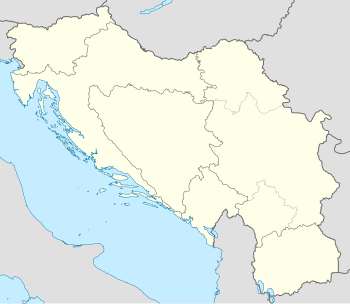1973–74 Yugoslav First League competition was the 46th top league season since 1923 in various incarnations of Yugoslavia. It was won by Hajduk Split by the tightest of margins over second placed Velež. The two teams were tied on points at the end of the season, so the goal difference decided the title.
1976–77 Yugoslav First League competition was the 49th top league season since 1923 in various incarnations of Yugoslavia. It was won in dominating fashion by Red Star Belgrade with a 9-point margin over the second placed team, which at the time set the record as largest ever points differential by which a team triumphed in the league.
The 1978–79 Yugoslav First League season was the 33rd season of the First Federal League, the top level association football competition of SFR Yugoslavia, since its establishment in 1946. Hajduk Split won the league title.
The 1980–81 Yugoslav First League season was the 35th season of the First Federal League, the top level association football competition of SFR Yugoslavia, since its establishment in 1946. A total of 18 teams competed in the league, with the previous season's champions Red Star successfully defending their title, finishing the season two points clear of runners-up Hajduk Split.
The 1981–82 Yugoslav First League season was the 36th season of the First Federal League, the top level association football competition of SFR Yugoslavia, since its establishment in 1946. The season began on 26 July 1981 and ended on 2 May 1982. Dinamo Zagreb led by Miroslav Blažević won their fourth title five points ahead of previous season's champions Red Star.
The 1979–80 Yugoslav Second League season was the 34th season of the Second Federal League, the second level association football competition of SFR Yugoslavia, since its establishment in 1946. The league was contested in two regional groups, with 16 clubs each.
The 1982–83 Yugoslav Second League season was the 37th season of the Second Federal League, the second level association football competition of SFR Yugoslavia, since its establishment in 1946. The league was contested in two regional groups, with 18 clubs each, two more than in the previous season.
The 1983–84 Yugoslav Second League season was the 38th season of the Second Federal League, the second level association football competition of SFR Yugoslavia, since its establishment in 1946. The league was contested in two regional groups, with 18 clubs each.
The 1984–85 Yugoslav Second League season was the 39th season of the Second Federal League, the second level association football competition of SFR Yugoslavia, since its establishment in 1946. The league was contested in two regional groups, with 18 clubs each.
The 1986–87 Yugoslav Second League season was the 41st season of the Second Federal League, the second level association football competition of SFR Yugoslavia, since its establishment in 1946. The league was contested in two regional groups, with 18 clubs each.
The 1987–88 Yugoslav Second League season was the 42nd season of the Second Federal League, the second level association football competition of SFR Yugoslavia, since its establishment in 1946. The league was contested in two regional groups, with 18 clubs each. This was the last season under that format as the following season featured unified second league with 20 clubs.
The 1990–91 Yugoslav Second League season was the 45th season of the Second Federal League, the second level association football competition of SFR Yugoslavia, since its establishment in 1946.
The 1959–60 Yugoslav Second League season was the 14th season of the Second Federal League, the second level association football competition of SFR Yugoslavia, since its establishment in 1946. The league was contested in two regional groups, with 12 clubs each.
The 1961–62 Yugoslav Second League season was the 16th season of the Second Federal League, the second level association football competition of SFR Yugoslavia, since its establishment in 1946. The league was contested in two regional groups, with 12 clubs each.
The 1962–63 Yugoslav Second League season was the 17th season of the Second Federal League, the second level association football competition of SFR Yugoslavia, since its establishment in 1946. The league was contested in two regional groups, with 16 clubs each, four more than in the previous season.
The 1963–64 Yugoslav Second League season was the 18th season of the Second Federal League, the second level association football competition of SFR Yugoslavia, since its establishment in 1946. The league was contested in two regional groups, with 16 clubs each.
The 1964–65 Yugoslav Second League season was the 19th season of the Second Federal League, the second level association football competition of SFR Yugoslavia, since its establishment in 1946. The league was contested in two regional groups, with 16 clubs each.
The 1965–66 Yugoslav Second League season was the 20th season of the Second Federal League, the second level association football competition of SFR Yugoslavia, since its establishment in 1946. The league was contested in two regional groups, with 18 clubs each, two more than in the previous season.
The 1966–67 Yugoslav Second League season was the 21st season of the Second Federal League, the second level association football competition of SFR Yugoslavia, since its establishment in 1946. The league was contested in two regional groups, with 18 clubs each.
The 1952 Yugoslav Second League season would be the 6th season of the Second Federal League, the second level association football competition of SFR Yugoslavia, since its establishment in 1946. It was cancelled before the start of the competition and the clubs were relocated to third level.
